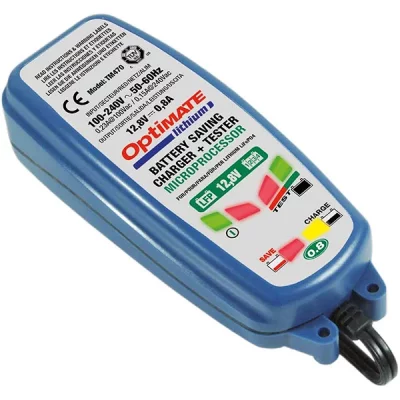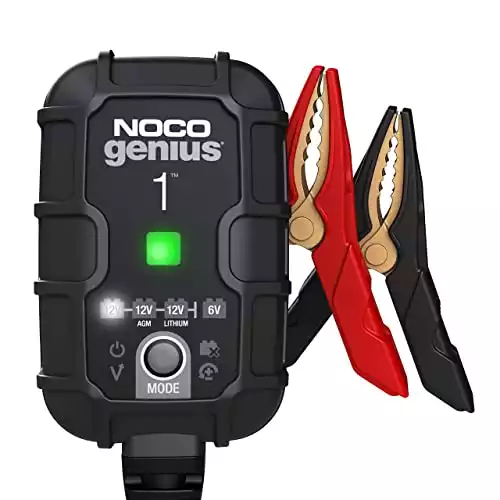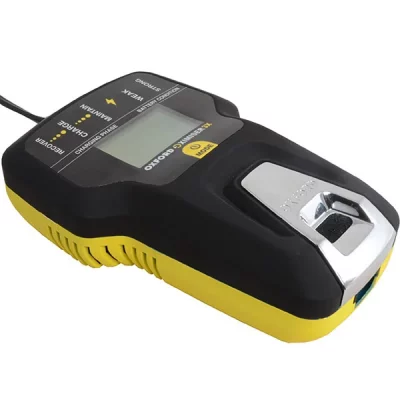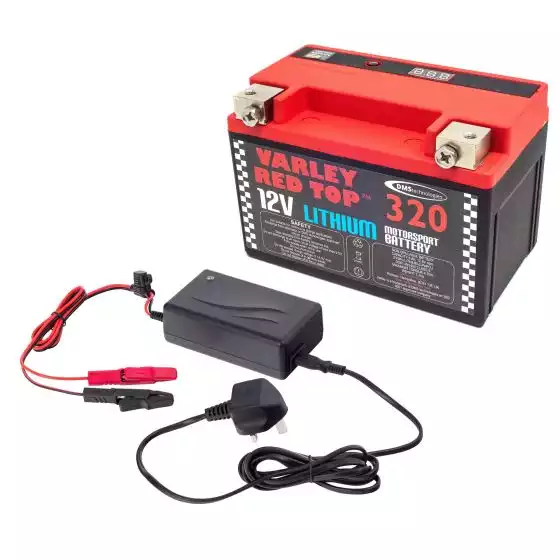If your motorcycle has a lithium battery fitted or you are thinking of swapping out to a lithium battery, you will need a lithium motorcycle battery charger.
Lithium batteries require special charging conditions to be kept in optimum working condition, and you will want to avoid any unwanted accidents resulting from improper charging.
Therefore, we have pulled together some of the best lithium battery chargers on the market.
We also have a comprehensive buying guide, so you have all the information you need about lithium batteries, including addressing some of the common myths that question lithium batteries’ reliability.
Here are our top lithium motorcycle battery chargers.
 TecMate OptiMate Lithium
TecMate OptiMate Lithium
Compact, Automatic, Great Value
This affordable charger will keep your lithium battery maintained and charged without you having to play around with any settings, just plugin and you're good to go.
TecMate OptiMate Lithium 0.8A Battery Optimiser
The TecMate lithium battery charger is specifically produced to charge and maintain 12V lithium batteries.
Check Prices on SportsBikeShop
It comes with clear instructions, which makes it very easy to use.
Once you have fitted the terminals to the battery, they can stay there permanently, and all you need to do is hook up the crocodile clips to keep the battery charged.
There are no switches or settings to change; hook the battery up, plug the charger in, and the optimiser does all the work.
This charger fits the term “does exactly what it says on the tin.”
Pros:
- Fully automatic, no switches to operate it, which eliminates user error protecting the battery
- Easy connection to the battery via connectors, which can stay permanently hooked up
- Solely a lithium battery charger, built specifically for lithium battery needs
Cons:
- Only works for lithium batteries, so if you also have a bike with a lead-acid battery, you will need a different charger.
Noco Genius 1
The Noco Genius 1 is the do-it-all battery charger, battery maintainer, trickle charger, and battery desulfator.
I have picked it for the list because it is a multi-tasking unit, and it works with all types of motorcycle batteries. So it is an excellent choice for those with more than one bike in the garage that may have different battery types.
The Noco has a cable just over 2m in length, so you must ensure your bike/battery is close to a wall socket.
The crocodile clips supplied come with eyelet terminals that can be unscrewed and secured onto the battery permanently. This makes the process of connecting the charger much easier.
The Noco also has an Integrated Thermal Sensor, which monitors the charge to ensure it doesn’t overcharge in high or undercharge in low temperatures.
The charger is built into the plug socket, making it a compact unit.
It is just a 1 amp charger, so it is generally best for trickle-charging lead-acid batteries, but it can fully charge them over time.
Lithium batteries, however, being smaller, have a high power density, take less time to charge regardless and need to be charged at a low voltage. So, the Noco Genius 1 is great for this.
A word of warning: the Noco charger is only suitable for lithium batteries with a BMS (Battery Management System).
You can also get the Noco charger in high voltages, so bear that in mind if you need something more powerful.
Pros:
- Suitable for 6V, 12V batteries and both lead-acid and lithium batteries
- Compact size
- Quick-release cable
- Good value
Cons:
- Only for use with lithium batteries that have a Battery Management System (BMS)
- Low voltage charge, slow-charging speeds
Oxford Oximiser 3X Motorcycle Battery Charger and Optimiser
Oxford is a staple motorcycle accessories company and a renowned industry brand.
This charger and optimiser will charge your battery up if it gets too low, and at the same time, you can leave it on to keep the battery charged up when your bike isn’t in use.
Check Prices on SportsBikeShop
Although, it is not recommended to use this oximiser for trickle charging your lithium battery as it is more suited to lead-acid batteries for that purpose.
It will, however, charge your lithium battery with no issues.
The charger is fitted with a voltage sensor, which will automatically adjust to the appropriate rate if the current is too high. This is especially important for lithium batteries.
The unit is super easy to use, and the instructions are very clear; it feels solid.
The only niggle is that the leads are a little short, which can mean removing your motorcycle battery every time or ensuring your bike is parked near a wall socket.
Pros:
- 2-year Oxford warranty
- Works with bikes, cars and leisure batteries, so is a one-stop charger for all your battery needs
- Charges/maintains all 12V batteries, so will look after your Lithium battery and any lead-acid batteries you have for your bikes
Cons:
- Expensive compared to other options
- Not a great option for trickle-charging lithium batteries
- Leads are a bit short compared to other options
Varley Lithium Li-5 Battery with 2 Amp Charger
One option if you are looking to switch your traditional lead-acid battery to a lithium battery might be this lithium battery which includes a charger.
Varley has started producing lithium batteries that can take the place of their Red Top lead-acid batteries.
There is a handy chart to determine which size lithium battery you need to replace your current traditional one.
This pack includes a Varley charger, so you know you are getting the best-suited charger for your battery.
It is an option to consider if you are switching to lithium, as you can get your battery and charger in one go and make the process easy.
The intelligent tech in the charger monitors the charge and prevents damage to your battery.
The battery only takes a few hours to charge fully.
Pros:
- Battery and Charger included
- Good value
- Quick charge time
- Intelligent electronics self-limit the charge rate to avoid battery damage
Cons:
- Can get quite expensive depending on which battery size you need
Buyers Guide
When using a lithium battery on your motorcycle, it is essential to know how they work and, more importantly, how they differ from traditional lead-acid batteries.
This information will mean you understand the importance of investing in a good lithium motorcycle battery charger.
What is a lithium battery?
Lithium batteries are sometimes referred to as LiFePO4, which is essentially the chemical makeup of the battery cells: Lithium (Li), Iron (Fe), and Phosphate (PO4).
A lithium battery works by the lithium ions moving from the positive electrode to the negative electrode through an electrolyte and then the reverse when discharging.
They are relatively new to the market and were initially significantly more expensive than lead-acid batteries.
However, prices have dropped over the last year or two, and they sit on par with standard battery pricing.
How does a lithium battery differ from a traditional motorcycle battery?
#1 Weight
Lithium batteries are lighter in weight than lead-acid batteries. They also have an increased power density, delivering the same or more power.
This often means they are physically much smaller in size too.
To enable easier compatibility, some manufacturers of lithium batteries have started to put the battery in the same size housing as a lead-acid battery to ensure it fits securely in the motorcycle.
#2 Power Draw
Lithium is more expensive than lead; due to this, manufacturers will produce their lithium batteries with the same cranking ability but a lower amp-hour (Ah) than a lead-acid battery.
This means lithium batteries are not great at sustaining accessories on the motorcycle that are directly hooked up to the battery when the bike isn’t running.
For example, I used to have a USB port connected straight to my battery, and a little blue light would stay on regardless of whether the bike was on or not.
When in regular use, this wouldn’t affect my lead-acid battery as the port would draw so little power.
However, had I been using a lithium battery, it would not cope with this and would constantly be dead, ultimately ruining the battery.
This isn’t a problem as you can wire in accessories such as USB ports and heated grips to have an on/off switch so that power is only being supplied when the bike is running (this is a far more sensible option anyway to prolong the life of any battery type.)
#3 Charging
Lithium batteries charge faster than lead-acid batteries due to their smaller size.
#4 Lifespan
Lithium batteries, provided they are looked after, have a longer lifespan than traditional batteries.
#5 Cranking Power
Lithium batteries have roughly 3 times the Cranking power of a traditional lead-acid battery.
Pros and Cons
Pros:
- Lightweight – 3 to 4 times lighter than a lead-acid battery
- More Cold Cranking Amps
- No acid is involved, so there will be no horrible leakages to contend with
- They self-discharge a lot slower than lead-acid batteries, so there is less chance of going out to start the bike to find the batteries dead
- They charge up quickly
- Long lifespan, which makes them very economical
Cons:
- Need a specific lithium battery charger
- Lithium batteries don’t cope well with very cold conditions (close to freezing)
- You cannot recover a truly flat lithium battery, however, they self-discharge slowly, so you should be able to avoid this situation
- Damage is possible if you use an unsuitable charger that pumps too much Voltage into the battery
- Cannot sustain accessories that draw power when the bike is not running, so be sure they turn off when the ignition is off
Misconceptions
There are some common misconceptions about lithium batteries that you may have heard.
When anything new comes on the market to replace something that has been tried and tested over the years, negative attention gets more press, and generally, people are resistant to change.
So let me take the opportunity now to debunk some of these theories floating around.
Myth #1: Lithium Batteries Catch Fire
The chemical makeup of LiFePO4 batteries used for motorcycles is incredibly stable and carries a much lower risk of setting alight.
Li-Ion batteries are made up slightly differently and are chemically less stable, and heat up much faster. These are not suitable for use in motor vehicles as a result.
A lithium battery is at no more risk of catching fire than a regular lead-acid battery.
However, it is essential to use an appropriate charger that monitors the voltage your battery receives.
Many lithium batteries will come with a Battery Management System (BMS) to ensure the battery receives the appropriate voltage and doesn’t overcharge.
With a Li-Ion battery overcharging has the potential for overheating and for a fire to occur.
However, with a LiFePO4 battery, the worst case would be that the battery warps.
Some lithium batteries do not come with a BMS or short circuit protection (to cut off the power supply if the charge rate is excessive); this is why it is vital to get the correct charger to control the charge rate for your battery.
Myth #2: Lithium Batteries Fail
How many of you have gone to start your bike after Winter to find that it is dead? Then you have charged the battery and figured out that the battery had given up?
I have.
Lithium batteries are no different from lead-acid batteries and are at no more risk of failure.
The only real way for things to go wrong is if you are not using an appropriate charger that emits the correct charge rate for the battery and ensures it doesn’t overcharge.
Lithium batteries have a lower self-discharge rate, so in theory, it is less likely that if you leave the bike for a few weeks, you won’t be able to get it going with a lithium battery.
Myth #3: Lithium Batteries Have a Reduced Lifespan
Lithium batteries actually have a longer lifespan than lead-acid batteries.
A traditional battery has an average lifespan of 2-3 years, whereas a lithium battery can last 10-12 years.
This idea came about because lithium batteries, when discharged to nearly empty, cannot be recovered, so they would need to be replaced.
However, if you keep your lithium battery out of the danger zone (charged above around 30%), it will serve you well for a long time.
Myth #4: Lithium Batteries Don’t Work in the Cold
This is the one misconception that holds some truth in it.
Lithium batteries produce less cranking power when it is particularly cold and, therefore, can struggle to get the bike started.
Warming your battery up beforehand can help with this; for example, turning your lights on or plugging something into your USB port will start to draw power from the battery and warm it up.
FAQ
-
Do you need a special charger for lithium motorcycle batteries?
Yes, you need a specific charger for lithium motorcycle batteries. This will ensure that the bike doesn’t overcharge and that it regulates the charge rate so the battery doesn’t receive too much voltage.
-
How do you charge a dead lithium motorcycle battery?
A completely dead lithium motorcycle battery is not recoverable. It will need to be replaced.
If a lithium battery completely runs out of power (anything from 2.5v and below), the damage caused is not reversible, and therefore you will not be able to recharge it.
-
How long does it take to charge a lithium motorcycle battery?
The average time for a lithium motorcycle battery to charge is 1-2 hours, whereas a traditional battery will take about 12 hours to charge.
-
Can a lithium motorcycle battery be jump-started?
No. Avoid doing this as the quick high voltage runs the risk of damaging the battery permanently.
-
Do any motorcycles come with a lithium battery as standard?
Some high-end motorcycles come with lithium batteries as standard, particularly bikes where weight-saving is a big advantage, such as the Ducati Panigale V4S and V4R.
Harley Davidson also produces three lithium batteries in different sizes for their motorcycles that you can upgrade to; these batteries cover most of their machines for the last twenty years.
Conclusion
Lithium batteries are the way of the future; therefore, you must get a charger that keeps up with the times to look after your battery for the bike.
I like the TecMate charger because it is automatic and leaves little chance of user error. It’s an excellent value charger that will keep your lithium battery in top condition.



